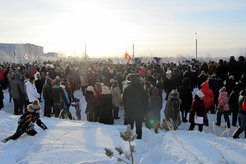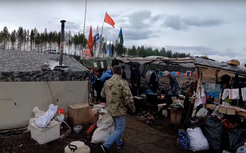'Shiyes is our Stalingrad': garbage riots and moral outrage in northwest Russia
Author: Daria Tereshina
Waves of ‘garbage riots’, as they are called in the media (Rus. musornye bunty), have swept across central regions of Russia in 2018-19. The first such demonstrations erupted on the outskirts of Moscow, where residents objected to the construction of new landfills and waste incinerators in their neighborhoods. Moscow suburbs have been receiving tons of metropolitan waste for many years. The sprawling dumps, many illegal, became lucrative businesses for municipal authorities, but local inhabitants complained about stench, headaches, and even intoxication caused by poisonous gases. As a result of the public outcry, a number of big dumps have been closed and the construction of a huge landfill cancelled. Yet the question of how to deal with the capital’s waste, estimated to be in the order of 8 million tons per year, remains urgent.
The solution to Moscow’s crisis has been sought in the transporting of garbage to neighboring regions such as Vladimir, Tula and Smolensk. In October 2018, the construction of a massive landfill in Arkhangelsk region was announced. The railway station at Shiyes, remote and deserted since 2002 (the nearest settlement, Urdoma, is 35 km away) seemed to be perfect for the purpose. The planners hailed their project as Europe’s biggest landfill and claimed that the ‘Ecological Technological Park’ would be safe both for humans and for the surrounding environment. It was designed to process up to 500 thousand tons of unsorted waste annually. Upon arriving from Moscow, the waste was to be packed, wrapped in plastic sheeting and buried for twenty years, after which re-cultivation of the park area would be undertaken. To set up the landfill, several hectares of nearby forest were cleared. In addition, it soon transpired that the Moscow authorities planned to expand the site and establish others in Arkhangelsk region.
Neither the Moscow developers nor the regional authorities could have anticipated that their project would receive a massive public backlash in a region hitherto regarded as ‘calm’ (Rus. spokojnyj) and politically apathetic. Opposition was initiated by local residents in the village of Urdoma, the nearest settlement to the station. They demanded a halt to the construction project on the grounds that it would endanger the regional ecology, above all by causing irrevocable damage to water resources. Moved by a desire to ‘save’ (Rus. spasti) the Pomor land1 and protect it from Moscow invaders, the Urdoma activists attempted to cut off fuel supplies to the site by obstructing the road with their bodies. An attempt to deliver fuel by air was also disrupted: the activists occupied a helicopter landing site and prevented the vehicle from landing.
But the bold actions of a handful of local activists would not have attracted much attention without the support of fellow citizens in Arkhangelsk, the regional capital, and in other northern cities. A wave of public rallies proclaiming opposition to the Shiyes landfill saw thousands of people taking to the streets to participate in mostly unauthorized demonstrations under the banner ‘The Pomor land is not a dump’ (Rus. ‘Pomorye ne pomoika’). Shiyes soon turned into a hot topic that threatened to destabilize the political leadership of Arkhangelsk region. The regional government strove to quell the unease by insisting that the garbage project was a developmental initiative that would benefit local population by attracting lavish investments from Moscow, Russia’s most prosperous city.

It would be misleading to gauge mass protest in northwest Russia primarily as a sign of growing environmental awareness, although this is how some media reports and environmentalists have represented the matter. Ecological concerns do surface in debates about Shiyes but they are inseparable from broader antagonisms driving public outrage. The fight against ‘Moscow waste’ is a response to uneven topographies of accumulation and distribution of wealth in Russia and the two-tier approach to citizenship that these topographies entail. In Shiyes the economic and political interests of Moscow clashed with the interests of those for whom the forest has long served as a primary means of survival. Hunting, fishing, and the gathering of mushrooms and berries are significant sources of additional income for rural Russians, especially elderly people struggling to supplement their meagre pensions. In the wake of a highly unpopular pension reform in 2018 that raised the retirement age, the role of the forest in rural survival strategies has become more important than ever. Against this background, the ease with which the interests of the commons could be sidelined in favor of elite groups sparked defiance. There is nothing new about anti-Moscow attitudes in regions such as Archangelsk. On this occasion, however, the usual accusations of misappropriating regional resources were amplified by the fact that Moscow was patently seeking to resolve its domestic waste crisis at the expense of the regions.
‘We are not second-class people’ (Rus. my ne ljudi vtorogo sorta) was a leitmotif of the ‘garbage riots’ in numerous rallies across the north. This message highlights perceptions on the periphery that only the residents of Moscow enjoy full citizenship rights, while they themselves are doomed to economic, social, and ecological dispossession. The garbage theme became so potent because it offered an apt metaphor for the two-tier citizenship regime: the waste of the wealthy was juxtaposed with a lack of social acknowledgment and disenfranchisement. The slogan Pomorye ne pomoika has more to do with certain class-related preoccupations than with ecological awareness; it is not about nature as such, but about the people who inhabit the social and geographical margins of Russia.
The regional authorities refused to acknowledge the protestors as worthy citizens, with a right to have a say in decisions affecting their livelihoods and wellbeing. The governor of Arkhangelsk region denounced the handful of activists in Urdoma as ‘shelupon’ – the rabble or scoundrels – and refused to negotiate with such people. Meanwhile, in the eyes of a wide public of sympathizers, the protesters gained moral authority, to the point of being glorified as ‘the defenders of North’ (Rus. zashchitniki severa). During the summer of 2019 the station at Shiyes attracted a steady flow of volunteers eager to join the camp and participate in the protest. The train station was promptly closed down by the authorities, but the volunteers continued to arrive using personal transportation and coordinating their routes through social media.

Being denounced as scoundrels and facing intimidation and violence from authorities, the activists in Shiyes refused to be cowed and defined as worthless citizens whose voices counted for nothing. To reassert their moral standing, they resorted to the symbols and rhetoric of the Great Patriotic War of 1941-45, an ultimate touchstone in Russia. Two camps have been named after Leningrad and Stalingrad, the sacred loci of the war. Everyday life in the camps is imbued with wartime symbolism and activities such as gathering to drink tea by the fireside while singing wartime songs accompanied by the accordion or reciting poetry that denounced the predatory politics of the current Russian government. The camps were adorned with slogans and flags. One poster proclaimed ‘Russia is huge, yet there is no place to retreat. Shiyes is our Stalingrad’, clearly echoing the famous slogan of the battle of Moscow in 1941-42: ‘Russia is huge, yet there is no place to retreat – Moscow is behind us’. The irony of this reference is that in today’s Russia it is Moscow that has turned into an inner enemy, as the center of power and privilege, while Shiyes, a marginal place in the rural hinterland, has assumed the moral valence of Stalingrad as a place of heroic resistance to indignity and dispossession. Volunteers at Shiyes reported a spirit of altruism and community, praised the austerity of life in the woods, and the lofty goals of the protesters. Certain about who are the heroes and who are the villains, in autumn 2019 the activists announced the establishment of commune at Shiyes. But the regional and federal governments are responding with violence and intimidation toward the most prominent activists and the construction of garbage landfill, halted since mid-June, has been resumed.
Note
1 Pomorye is a historical designation of Arkhangelsk region. The name goes back to the first Russian settlers on the White Sea coast who called themselves pomory, literally seasiders.

